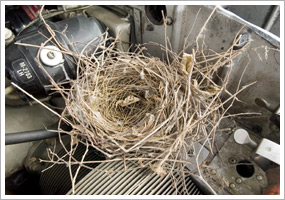| The following stories from the July 1, 2011, edition of AOPA ePilot were provided to AOPA members who expressed an interest in the particular subject areas. Any AOPA member can receive information tailored to their areas of interest by updating their preferences online |
training tipsKnowing the ‘why’ Like the cool seasons, spring and summer have their special concerns. For example, why should you give the cowling and the fuel sample extra special attention during preflight inspections? As any bird can tell you, a trainer that is tied down on an airport ramp is an irresistible nesting place—especially if the aircraft does not have cowl plugs installed. Atop the engine or inside the tailcone are favorite nest sites. One telltale sign is some blades of grass protruding from entry points. Give your fuel sample the attention it deserves because ramp-pelting downpours from thunderstorms can penetrate leaky or improperly closed fuel caps and contaminate your fuel. During local summer flights, you have probably noticed that your trainer’s takeoff and climb performance is less peppy than it was weeks earlier. Acceleration for takeoff doesn’t seem as brisk, and climbing to traffic pattern or cruise altitude takes longer. Why? If you can state a good explanation, you have demonstrated a grasp of the aerodynamic concept of density altitude. Accident reports regularly demonstrate that many pilots don’t grasp the idea or appreciate its potential to cause trouble—an especially nasty trap when taking off from airports where operations during cooler weather pose no difficulties. Learn from their mistakes and avoid their miscalculations. Your weather briefing promises cloudless skies and calm winds, so you are surprised to discover that today’s visibility is poorer than the unrestricted value you expected. Why? In stable air masses—those with little vertical movement of air— haze can form and reduce visibility over extensive areas. Sometimes you may be able to top the layer, but remember to be sure that you are flying with visual reference to the surface. With forest fires burning over large portions of western states, smoke can affect visibility, sometimes a great distance away from the source fires. Restricted visibility also holds the threat of hidden embedded weather. Another summer tip is to routinely monitor weather broadcasts for hidden hazards and be ready with a plan of action, just in case. training productsPilot Training Solutions written test preparationPilot Training Solutions recently introduced a new approach to studying for the private, instrument, and commercial knowledge exams. The company uses DVDs that are aimed directly at the knowledge exam, rather than the entire pilot course. Each sells for $99.
Note: Products listed have not been evaluated by ePilot editors unless otherwise noted. AOPA assumes no responsibility for products or services listed or for claims or actions by manufacturers or vendors. final exam
Question: My friend hit a bird while flying the other day and was wondering if it was something he should report. How common are bird strikes, and what should I do if I have one?
Answer: The number of bird strike reports has increased, but many collisions still go unreported; one estimate claims 60 percent of bird strikes never find their way to the FAA database. If that estimate is accurate, more than 145,000 strikes have occurred since 1998. One of the best things you can do to avoid a bird strike is to try to stay away from areas where birds congregate. For example, city or county landfills often attract large flocks of birds. Also, be familiar with and avoid migratory bird routes. If you are involved in a bird strike, it is important to report it once you have landed safely. Fill out FAA Form 5200-7 Bird/Wildlife Strike Report (you can use an FAA-approved online version or download a paper version). If you see that you are flying toward a flock of birds, never try to descend and fly under them because birds usually dive. Climbing and turning away from them is the best option if you find yourself face to face with the natural aviators. For more on the topic read the Air Safety Institute Bird Strikes Safety Brief.
Got a question for our technical services staff? E-mail [email protected] or call the Pilot Information Center, 800/872-2672. Don’t forget the online archive of “Final Exam” questions and answers, searchable by keyword or topic. |
 Summer is a great time to make a run at completing your flight training program. Although summer flying is often comfortable and generally free of winter’s inconveniences, don’t become casual about your preparation.
Summer is a great time to make a run at completing your flight training program. Although summer flying is often comfortable and generally free of winter’s inconveniences, don’t become casual about your preparation.

